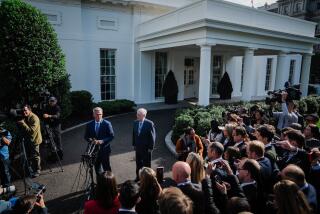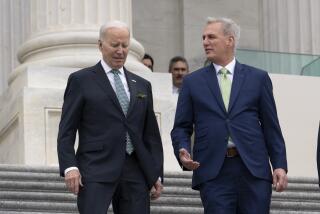World Debt Crisis Solution Proves Elusive
- Share via
For some time now, the world banking system has been struggling from one crisis to the next over the ability of Third World nations to repay their debilitating debts. Currently, the United States is hard at work trying to sell yet another plan in the hope that it will have longer term impact. Yet the plan it has laid out sounds a lot like the earlier ones--it will require already overexposed banks to lend these nations even more money.
What’s going on? Why doesn’t somebody work out a more durable solution?
The answer is nobody can because governments and bankers have few options. Any really tough measures will produce intolerable problems. As a result, all that the experts can produce is half-solutions that will keep matters under control at least temporarily.
What got the banking system into this mess in the first place was overindulgent credit policies, inspired in part by the flow of deposits from the newly rich oil producing countries. At the time, it appeared that developing nations could sustain substantial growth.
It turned out they couldn’t, not without increasingly severe inflation and not in the face of worldwide recession and collapse in the price of raw materials on which many Third World countries depend for export income.
What’s done is done. The money was lent. Some of it was lost, and by most banking standards the losses should simply be written off. If it were a Lockheed or a Chrysler, another alternative would be to convince the American public that there is enough self-interest in saving jobs and avoiding bank failures to put up a guarantee to keep the company going.
The problem in this international situation is that politically it’s not likely that taxpayers of the major industrial nations would agree to a bail-out of some remote land. Banks could probably forgive a little of the debt and not weaken themselves too much, but to do so would be to reward those nations that have done the least well in keeping up debt payments. Moreover, it would cut off further credit needed to help those nations get going.
To avoid either possibility, the industrial nations have been pressuring the Third World debtors to shoulder some of the loss by taking it out of their own citizens’ hides. They do this through austerity programs that limit personal income growth and stress export production to raise the funds to make some loan payments. The policies have produced some moderate results, but much of the export revenue goes just to pay interest on the international debt.
Moreover, prolonged austerity in countries lacking the political stability of the major democracies promises growing unrest and potential chaos. Hence, this answer, too, has its limits.
So the United States has embarked on a somewhat new path. First, it wants to get more major banks around the world to join in providing added credit, about $20 billion worth over three years, along with $9 billion from the World Bank and International Monetary Fund. The developing countries in turn would be asked to try Reagan Administration-type economics--that is, lower taxes and less government involvement in economic enterprise. The hope is to generate some healthy growth. That in turn, it is hoped, will make these countries better loan prospects in the future.
There is risk in this plan, too. Most significantly, it presumes that the Reagan policies will work somewhat better in the developing countries than they have here. U.S. taxes have been reduced and the U.S. economy has helped to lead the world out of recession. But government spending hasn’t been reduced and so federal deficits are mounting. It will be difficult for Third World countries to reduce their government spending, as well, and it will be much harder for them to finance a mounting government deficit.
There is one other element in the program. That is a recognition that faster growth in the world economy will help strengthen commodity prices and improve Third World fortunes. The gamble is that such growth can be generated without rekindling inflation. If so, robust world economic growth may make the U.S. plan a long-term one. If not, the outlook is for many years of working out stopgap solutions.
More to Read
Inside the business of entertainment
The Wide Shot brings you news, analysis and insights on everything from streaming wars to production — and what it all means for the future.
You may occasionally receive promotional content from the Los Angeles Times.










